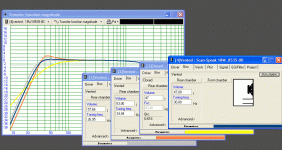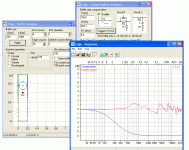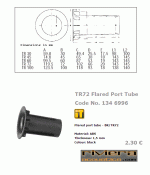Recently I both drivers (Scan Speak 18w8535-00 + 9500). First I make Troels Gravesen cabinet http://www.troelsgravesen.dk/download/2.5_Clone.pdf. I tried many types of crossovers but withouth result. Sound was muddy, undertone without expanse in middlem, bass was deep but without attack (energy). I think the cause of this was small volumen of the cabinet. After nearly a week of work I quit of this cabinet.
Next solution was Event http://www.audiocomponents.nl/speakers/scanspeak/classic/tekening/event_1.htm. Results was better then previous but sound was bad though. I have opossite sound from previous. Middle was wide but without warming and definition, bass was deep but without definision. I worked on dumping but without visible results. There is last solutin. Close cabinet. I searched internet but without results. I wish to build BR or TL but I'm in the dead end. I have not equipment to mesure T/S parameters and work further.
I'm count on you people 😉
Any hint will be highly woth.
best regards
Next solution was Event http://www.audiocomponents.nl/speakers/scanspeak/classic/tekening/event_1.htm. Results was better then previous but sound was bad though. I have opossite sound from previous. Middle was wide but without warming and definition, bass was deep but without definision. I worked on dumping but without visible results. There is last solutin. Close cabinet. I searched internet but without results. I wish to build BR or TL but I'm in the dead end. I have not equipment to mesure T/S parameters and work further.
I'm count on you people 😉
Any hint will be highly woth.
best regards
Here is link corrections
1. http://www.troelsgravesen.dk/download/2.5_Clone.pdf
2. http://audiocomponents.nl/speakers/scanspeak/classic/tekening/event_1.htm
1. http://www.troelsgravesen.dk/download/2.5_Clone.pdf
2. http://audiocomponents.nl/speakers/scanspeak/classic/tekening/event_1.htm
It’s hard for me to understand what the problem is. Undertone, muddy sound? Do you mean the tweeter was lower then you use to? Classic clone, so to speak uses D2010/8513, not D2905/9500.
I know that some people used 9500 with great success but it does require a different crossover.
I myself build the box to the actual original size, used variable density panels and 2 braces.
Stuffing was moderate and I kept port section almost clear of it. I am not having any problems at all. Speaker sounds pleasant for what it is.
I know that some people used 9500 with great success but it does require a different crossover.
I myself build the box to the actual original size, used variable density panels and 2 braces.
Stuffing was moderate and I kept port section almost clear of it. I am not having any problems at all. Speaker sounds pleasant for what it is.
Hi,
azoran, what boxes do you have (internal dimensions)? and size of ports if you played w/them allready, you can change after you are set. Size of the front baffle also is important? Did you look at a stronger bass like the one I post in the bottom? Are you building BR (bass reflex box)? You might have a good list of xover parts allready. Post it if you want to save some money but this is not important at this stage. I don't know the xover you are playing with, is it Troels on page 28? Post some detailed information. You can also pad the front of the tweeter for a better appearence with cork (or velvet or some other foammy material as in the 8513) to entertain yourself. 😀
List of reference from ScanSpeak:
SS Classic 6.5" Midwoofer 18W/8535-00
http://www.tymphany.com/18w-8535-00
SS Classic 0.75" Tweeter D2010/851300
http://www.tymphany.com/d2010-851300
SS Classic 1" Tweeter D2905/950000
http://www.tymphany.com/d2905-950000
ProAc Response 2.5; 38L, Fb=40Hz original
http://highend.puslapiai.lt/?speakers/8
8535 ProCub; 47L, Fb=29Hz (BR)
http://highend.puslapiai.lt/?speakers/7
azoran, what boxes do you have (internal dimensions)? and size of ports if you played w/them allready, you can change after you are set. Size of the front baffle also is important? Did you look at a stronger bass like the one I post in the bottom? Are you building BR (bass reflex box)? You might have a good list of xover parts allready. Post it if you want to save some money but this is not important at this stage. I don't know the xover you are playing with, is it Troels on page 28? Post some detailed information. You can also pad the front of the tweeter for a better appearence with cork (or velvet or some other foammy material as in the 8513) to entertain yourself. 😀

List of reference from ScanSpeak:
SS Classic 6.5" Midwoofer 18W/8535-00
http://www.tymphany.com/18w-8535-00
SS Classic 0.75" Tweeter D2010/851300
http://www.tymphany.com/d2010-851300
SS Classic 1" Tweeter D2905/950000
http://www.tymphany.com/d2905-950000
ProAc Response 2.5; 38L, Fb=40Hz original
http://highend.puslapiai.lt/?speakers/8
8535 ProCub; 47L, Fb=29Hz (BR)
http://highend.puslapiai.lt/?speakers/7
I'm working on Troel project 1000x200x265 (19mm MDF) with tube on the back on 430mm from the bottom.
Tube diameter 70mm x 135mm.
http://www.troelsgravesen.dk/download/2_5_clone_cabinet_drawings.zip
Yes I tried Xover from Troel project page 28. My problem isn't Xover. I think cabinet is the problem. I followed your last link and I want to try 8535 ProCub; 47L, Fb=29Hz (BR) design but can't find cabinet drawing.
If you need any other details ask free.
thanks for your effort 🙂
Tube diameter 70mm x 135mm.
http://www.troelsgravesen.dk/download/2_5_clone_cabinet_drawings.zip
Yes I tried Xover from Troel project page 28. My problem isn't Xover. I think cabinet is the problem. I followed your last link and I want to try 8535 ProCub; 47L, Fb=29Hz (BR) design but can't find cabinet drawing.
If you need any other details ask free.
thanks for your effort 🙂
azoran said:My problem isn't Xover. I think cabinet is the problem. I followed your last link and I want to try 8535 ProCub; 47L, Fb=29Hz (BR) design but can't find cabinet drawing.
What metod are you using for the size of the box/vent?
Here it is a rough calculation using WinISD. You can use this settings with your existing box, but (your) port is not that favourable at such high frequency (35Hz). To bring it to 47L/32Hz you need a circ. vent of 70mm-d/200mm-l or one of 50mm-d/90mm-l. An idea is to pad the inside with a soft foam pipe of the same size or to make it longer about 196/200mm length. I have one that states "75mm port with variable length" from 135mm to 255mm (max.), "PL 75" that is in reality a 66mm int. diametre from www.caliber.nl. You can also use cardboard tubes. Do you have the ports/vents cut already in the speaker?
For a 47L/30Hz a 50mm/108mm or a 70mm/230mm,
for a 47L/29Hz a 70mm/248mm,
for a 50L/32Hz a 70mm/180mm.
This if they are free ends with end correction (E.C.) of 0.614. Take all this only as a guide not like the best set-up. I am also making sure you are using the size of the box (volume) in liters w/out the volume of the (internal parts) speakers, vents, xovers, braces, wall thickness.
I assume your baffle is 1000x200mm.
Attachments
I'm planing to build cabinet 1000x216x311 (outher dimension) with 18mm MDF with driver centred (in baffle) at 750mm height. Where to place vent on front or on rear panel and on which height? When I have this data I'll resume my work, then follow work on Xover.
azoran said:I'm planing to build cabinet 1000x216x311 (outher dimension) with 18mm MDF with driver centred (in baffle) at 750mm height. Where to place vent on front or on rear panel and on which height? When I have this data I'll resume my work, then follow work on Xover.
Front baffle dimension should be 1020x225mm, a .pdf is available with plans for this speaker. Your port seems to be close to what is necessary if counting with less internal volume more close to the 34/38/40L, you can read the details on the next link. The bottom inside panel might adjust the desirable height. Also the port is reported to be in the back.
Width: 225mm
Height: 1020 mm
Depth: 255mm
http://www.geocities.com/diyproac25/dimensions.htm
You can use your own dimensions dough.
Though,
- Dimensions: 42" (1066mm) high on plinths with spikes x 8 3/4" (222mm) wide x 10" (254mm) deep 😎
http://www.diyzone.net/article.php?sid=600
http://stereophile.com/floorloudspeakers/196proac/index2.html
You should maintain the front baffle with the original dimensions of ~1020x222/225mm and change depth from the announced 254/255mm to your dimension of 311mm if you want more volume to manipulate bass.
- Dimensions: 42" (1066mm) high on plinths with spikes x 8 3/4" (222mm) wide x 10" (254mm) deep 😎
http://www.diyzone.net/article.php?sid=600
http://stereophile.com/floorloudspeakers/196proac/index2.html
You should maintain the front baffle with the original dimensions of ~1020x222/225mm and change depth from the announced 254/255mm to your dimension of 311mm if you want more volume to manipulate bass.
port type & sizes
This is to show that a port type that is flanged on one side (one flanged end/...or two) gives also a lower frequency on the bass of less ~1Hz, what is good in your case. For your case the lenght of the tube (170mm) is not enough with same diameter (blue line). So you need a longer tube or a smaller diameter, as I said in the post before.
The original ProAc has a predominant frequency in relation to Volume/Tuning freq. that they call a "bass performance outstanding" that causes "a few small anomalies" in "the lower midrange". Or it does not produce enough midrange or it's a bit weak (-10dB at 400Hz - stereophile, 1996).
Now with that size of port 70x140mm we can see that it works well with the 38L box and a tuning freq. of ~36Hz on the pic with the green line;
with two free ends:
1. case: End Correction 0,614 ~37Hz
flared port tube:
2. case: End Correction one flanged end ~36Hz.
This means we can manipulate to reinforce the bump or peak or lessen it around 50Hz.
This is to show that a port type that is flanged on one side (one flanged end/...or two) gives also a lower frequency on the bass of less ~1Hz, what is good in your case. For your case the lenght of the tube (170mm) is not enough with same diameter (blue line). So you need a longer tube or a smaller diameter, as I said in the post before.
The original ProAc has a predominant frequency in relation to Volume/Tuning freq. that they call a "bass performance outstanding" that causes "a few small anomalies" in "the lower midrange". Or it does not produce enough midrange or it's a bit weak (-10dB at 400Hz - stereophile, 1996).
Now with that size of port 70x140mm we can see that it works well with the 38L box and a tuning freq. of ~36Hz on the pic with the green line;
with two free ends:
1. case: End Correction 0,614 ~37Hz
flared port tube:
2. case: End Correction one flanged end ~36Hz.
This means we can manipulate to reinforce the bump or peak or lessen it around 50Hz.
Attachments
If you want to look at flared port tubes the TR 60 (maybe for a bigger volume box >40L) and the TR 72 maybe for the original ProAc (<40L) and both with 143mm lenght, look good.
http://www.riviera-acoustics.com/catalog/product_info.php?cPath=43_26_86&products_id=447&language=en
http://www.riviera-acoustics.com/catalog/product_info.php?cPath=43_26_86&products_id=447&language=en
Attachments
azoran said:Recently I both drivers (Scan Speak 18w8535-00 + 9500). First I make Troels Gravesen cabinet http://www.troelsgravesen.dk/download/2.5_Clone.pdf.
R-Carpenter said:It’s hard for me to understand what the problem is. Undertone, muddy sound? Do you mean the tweeter was lower then you use to? Classic clone, so to speak uses D2010/8513, not D2905/9500.
I know that some people used 9500 with great success but it does require a different crossover.
Hi azoran,
Just another question. You mentioned that you made your decision in favor of the 9500 instead of the 8513 why, was it mainly because of the Troels project (and by the way, I have a lot of respect for his careful projects presentations).
The 8513 (original ProAc 0.75" Tweeter) seems to be more protruding on the 5K/10K/20K range than the 9xxx line (Classic 1" Tweeter), besides being more economic. The 9xxx SS line has a lower resonance frequency what is very good, the 9700 has more power (225W) and is in close similarity to the 8513 with output in frequency going up 4dB. It does not have ferro fluid and has prices being more than double.
Also some tests to the 9xxx Scanspeak line by ucla88 from www.diyaudio.com and his website at www.audioheuristics.org named:
"Tweeter Group 2-Scan Speak 9300, 9500, and 9700"
http://www.audioheuristics.org/measurements/Testing/Tweeter2/scan_speak_9300_and_9700.htm
in post #134 underRecently I both drivers (Scan Speak 18w8535-00 + 9500). First I make Troels Gravesen cabinet http://www.troelsgravesen.dk/download/2.5_Clone.pdf. I tried many types of crossovers but withouth result.
Sound was muddy, undertone without expanse in middlem, bass was deep but without attack (energy). I think the cause of this was small volumen of the cabinet. After nearly a week of work I quit of this cabinet.
Next solution was Event http://www.audiocomponents.nl/speakers/scanspeak/classic/tekening/event_1.htm.
Results was better then previous but sound was bad though. I have opossite sound from previous. Middle was wide but without warming and definition, bass was deep but without definision. I worked on dumping but without visible results. There is last solutin. Close cabinet. I searched internet but without results. I wish to build BR or TL but I'm in the dead end. I have not equipment to mesure T/S parameters and work further.
I'm count on you people 😉
Any hint will be highly woth.
best regards
https://www.diyaudio.com/community/threads/why-do-proac-2-5-clones-fail.211584/page-7
I have explain the main reason to the observations mentioned above.
Additional effects through low Qms/Rms values of the Scan Speak Bass cannot be completely ruled out either.
Clean and tight bass and very low resp. deep bass at the same time is not possible by use of this bass driver size.
If one plan a subwoofer into your loudspeaker diy project right from the start a driver like those under
https://www.fane-international.com/downloads/FANE-SOVEREIGN-PRO-8225-DS141117.pdf
blown away the Scan Speak 18W/8535 under
https://www.scan-speak.dk/datasheet/pdf/18w-8535-01.pdf
- check out post #98 under
https://www.diyaudio.com/community/threads/best-8-inch-woofer.278192/page-5
But f3 is around 70Hz or 80Hz - this means, very clean and tight bass without darkness - perfect for a satellite speaker.
Without subwoofer this Scan Speak 18W/8535 mentioned in the PDF attachment is a good choice, but without the demands for bass precision being completely satisfied during a listening test.
Attachments
Last edited:
- Home
- Loudspeakers
- Multi-Way
- Proac 2.5 clone cabinet problem



